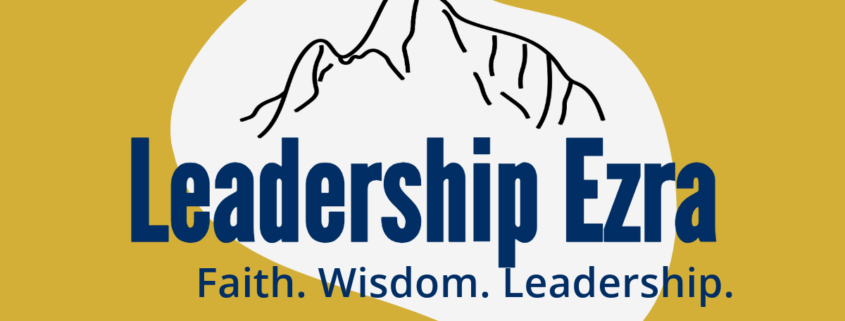Leadership Ezra: Who’s In Charge Here? (Part 12, Do You Have a Plan?)
In thirty years of life and experience in leadership roles in Christian organizations, there are lessons that I learned (and continue to learn) from the life of ministry to which God called me. Over that time, He taught me lessons based on stories, principles, and truths from the Bible that have been translated into personal application. This series of articles focuses on a set of those lessons drawn from the book of Ezra in the Old Testament (and then published in my latest book). This week, in part 12, I am discussing one of several lessons on the practice of leadership, this one is about tools for strategic planning.
Strategic Planning
I was fairly young and had just become the headmaster of a small Christian school. I knew that the school had been operating with an interim headmaster, that enrollment had drastically declined over the previous couple of years, that they had recently gone through a major shift in identity, that resources were very limited, and that a desired plan for building a new school facility appeared to be stalling out. I felt the emotional mix of excitement about the possibilities and anxiety of feeling overwhelmed and in over my head, but I also knew that God had clearly and specifically directed in my life to put me in this position. I had previous administrative experience, but not as a head of school, and I had had no real training on strategic planning. I simply knew that I had a major project ahead of me, and so I rolled up my sleeves and began to assemble a plan of action.
I wish I could say that I took time to listen to people as I prepared my plan, but I didn’t (this was one of the other important lessons I learned in the process). I did, however, begin an intentional process of trying to determine the current status – resources, people, programs, obstacles, etc. – and identify the direction and goals, followed by prioritizing those goals and deciding what steps would need to be taken to achieve those goals. My simple process involved writing these things (both the current status items, and the goals and needs) on individual, notebook-sized sheets of Post It notes, and placing them on a large empty wall. When they were all up on the wall, I stepped back and began to look at them, individually and together, and then began to sort them into categories and themes and looking for connections, arranging them by groups, priority, and sequential order of process. When I was all done, I had my first official strategic plan.
Strategic planning could be defined as the process of creating and initiating a specific plan to address a determined and identifiable goal or need, and my own process in that school was a very crude (although efficient and effective for me at that time and place in my leadership development) form of strategic planning. In the years since, I have learned from experience, education, and training much more about effective – and ineffective – strategic planning (and about the importance of listening to people and giving them a voice in the process). Therefore, even though I helped to facilitate excellent change and growth – with credit actually going to God much more than me; I was only the instrument He chose to use – I now know a number things I would have done differently, or additionally, in my first attempt at strategic planning.
There is an experience that takes place in the book of Ezra, in chapters 9 and 10, that provides a great source of learning for us on this topic. Ezra had already successfully led a group of leaders back to Jerusalem from their place of captivity. The physical temple had already been reconstructed, and now Ezra had returned to facilitate the restoration of the spiritual temple – the hearts of the people. After he arrived in Jerusalem, he took the time to assess the situation and determined the issues (in this circumstance, they were the issues of unfaithfulness and unholiness), and prepared a strategic plan to address the issues and restore the people and the nation before God. This is the process we see when we focus in on Ezra 10:6-17.
When we analyze the description of this event in these verses, breaking it down into its sequential steps, what we see illustrated is an eight-step process of strategic planning (each of the steps is illustrated in specific ways in these verses). We find a description of the process, from inception to implementation, of a specific and measurable plan to address the issue that they faced. In this process, Ezra led the way by his example and his intentional methods, showing us how we too can undertake the task of strategic planning for our ministries and organizations.
- Preparation: Step one in the process is preparation (v. 6). As a leader, you need to enter the process ready, and with the right attitude, taking ownership. Spend some time in reflection and analysis, resolving yourself for the task ahead and building your own enthusiasm and commitment. And as Ezra demonstrated, this includes your spiritual preparation, humbling yourself before God, ensuring that your own heart is clean and submitted to him.
- People: Step two is to gather the right people together (vv. 7, 9). Include (a) all those who will be affected, (b) those who will help make the process happen, and (c) representative leadership from among the followers. Provide the appropriate motivation to get the right people to participate.
- Need: Step three is to identify the issue or need that must be addressed (v. 10). It falls on us to provide a succinct and understandable statement of the issue, problem, or need that must be addressed, attacked, or resolved. Before you can prepare a plan, you must be able to articulate what it is that needs to happen, or where it is that you need to go, based on where you currently are and what you are currently doing. Identify the issue and state it clearly, and don’t make it complicated.
- Goal: Step four is to identify the goal or goals that are to be achieved (v. 11). This implies identifying the means and steps of correcting or resolving the need that has been identified. More specifically, it means determining what will need to be accomplished that, when done, will fulfill the plan. Then you need to follow your identification of the need with the establishment and communication of how that need must be met. You have given the vision and direction; now give the steps it will take to get there.
- Listen: Step five is to listen, giving people a voice in the process (vv. 12-13). People need to be given the opportunity to respond to the information that they are hearing. We need to let people have a voice, especially those people who may be impacted or affected and those people who have “ground-floor knowledge.” Then, listen to what they say, and let them know that they have been heard.
- Process: Step six is to establish a process for implementing the plan (vv. 13-14) with these four components: (a) d the steps in the process, from start to finish; (b) select leaders to oversee the process of carrying out the plan, and this also helps to provide accountability; (c) create a calendar, schedule, or timeline; and (d) when all is said and done, it needs to be more than just talk, and so the process has to be initiated.
- Obstacles: Step seven is to identify and prepare for obstacles and opposition (v. 13). See the obstacles early that will hinder the plan, and expect both opposition and support. There will be obstacles, there will be opposition, there will be support, and you need to develop the ability to “foresee,” learning to identify where these might or will come from so that they can be addressed or responded to.
- Implement: Step 8 is the final step, the one of implementation (vv. 16-17). This is the action of implementing the plan and the process. Words and ideas have little value if they are never put into action. Once we have the plan prepared and communicated, put it into action, keeping the end in focus, and identifying when the goals have been reached.
I am sure that there are other tools, strategies, and principles for strategic planning that can help you in your effectiveness as a leader, but these eight that are illustrated through Ezra’s experience provide some basic steps that we can use. Along the way, one of the tasks of a leader is to periodically assess what is happening, in order to confirm that the process is working (so that adjustments can be made, if needed) and to ensure that the goals are being reached. And then, when you arrive at the end, take time to celebrate!





